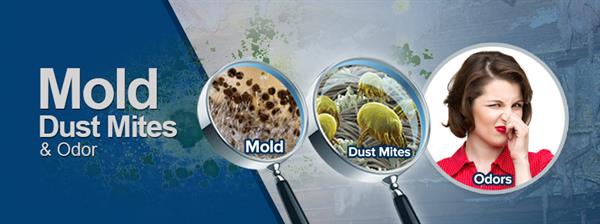Homes are designed to keep heat inside during the winter. In addition, most people make an extra effort to seal out the cold by adding extra insulation and filling any cracks that may cause drafts. By doing this, they are also sealing out fresh air. This lack of fresh air increases the concentration of both allergens and pollutants in the home and lowers the indoor air quality. According to the EPA, poor winter indoor air quality can contribute to respiratory conditions such as asthma.
There are many common indoor allergens and pollutants. Some of the most common include:
- Mold and mildew can grow and multiply when windows are closed. Steam from kitchens and bathrooms can build up and give mold and mildew a place to multiply.When this occurs, they produce airborne spores that can be inhaled.
- Dust mites thrive during the winter as they feed mainly on dead skin cells. With Since people indoors more, this provides them a greater supply of “food.” The common household dust mite produces a powerful enzyme that can irritate and break down living cells.
- Various VOCs (volatile organic compounds) are produced by many common household cleaning products and building materials. Through a process called “out-gassing” these common products release chemicals, such as methylene chloride, tetrachloroethylene, and formaldehyde, into the home.Many of these chemicals have been linked to respiratory diseases or cancer.
- Carbon monoxide and nitrogen dioxide can be given off by gas-fired appliances such as stoves and dryers. Carbon monoxide is a potentially deadly gas that interferes with the body’s ability to distribute oxygen.

Poor indoor air quality can cause headaches, dizziness, fatigue, and other allergic symptoms. According to the EPA, more serious conditions like asthma can be aggravated and worsened.
To improve indoor air quality, the Environmental Protection Agency (EPA) recommends three key strategies: source control, ventilation, and air cleaners or purifiers.
- Source control: This involves removing likely sources of pollution or reducing their emission. This could include asbestos or old appliances that leak gas (stoves or clothes dryers). This can be the least costly way to correct poor air quality.
- Ventilation: At its most simple, this can be accomplished by opening a window or door. Doing this adds fresh air from outside and removes the polluted air inside. The potential for extreme cold during midwestern winters makes this cost prohibitive and simply not practical. The use of ERVs or HRVs is the best way to provide fresh air during the winter by using the warm indoor air that is being exhausted to heat the fresh outdoor air. This is especially effective for lowering VOCs and other gaseous pollutants.
- Air cleaner and purifiers by Trane, American Standard, Honeywell, Aprilaire, RGF, GPS, and Air Scrubber do not remove gas or other airborne chemicals but they do capture particulate matter. Ask a professional to help choose the device that has the capacity to do the best job in your home.

In general, to maintain healthy indoor air, especially during the winter:
- Keep dust down—dust and vacuum regularly to reduce airborne pollutants like mold, pollen, pet dander, and dust mites.
- Replace furnace filters regularly—the furnace filter is a first-stop for many airborne irritants.
- Purchase a carbon monoxide detection device—this is important to ensure you are alerted to the presence of this colorless, odorless and very lethal gas.
- Use non-toxic cleaning products—this will minimize chemical fumes.
- Clean mold-prone areas in the home—the combination of extra moisture and low ventilation can encourage the growth of mold.
- Install air purifiers—they filter contaminants from the air.
Indoor air quality is important year-round but definitely needs extra attention in the cold weather. Contact your local HVAC contractor to assist in maximizing IAQ.


